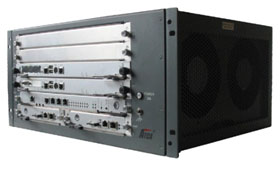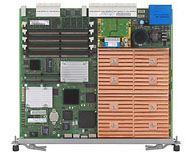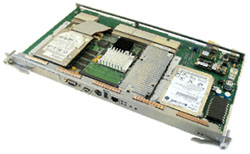|
 Программный коммутатор (CS) служит для взаимосвязи сетевых элементов NGN, шлюза доступа (AGW), шлюза сигнализации и медиа-шлюза (SMG), а также сервера приложений (AS) и медиа-сервера (MS). Программный коммутатор обеспечивает предоставление основных и дополнительных услуг с использованием различных протоколов сигнализации для обслуживания пользователей с различным терминальным оборудованием. Он может применяться в коммутаторах различных уровней - от класса 5 (коммутатор локального уровня) до класса 4 (коммутатор транзитного уровня). Программный коммутатор (CS) служит для взаимосвязи сетевых элементов NGN, шлюза доступа (AGW), шлюза сигнализации и медиа-шлюза (SMG), а также сервера приложений (AS) и медиа-сервера (MS). Программный коммутатор обеспечивает предоставление основных и дополнительных услуг с использованием различных протоколов сигнализации для обслуживания пользователей с различным терминальным оборудованием. Он может применяться в коммутаторах различных уровней - от класса 5 (коммутатор локального уровня) до класса 4 (коммутатор транзитного уровня).
Программный коммутатор SI2000 CS разработан на основе двух открытых аппаратных платформ массового производства: PCI (MEA) или стандартной ATCA, разработанных для построения систем связи NGN операторского класса.
 |  | Процессорная плата CVH
для платформы ATCA | Процессорная плата CVJ
для платформы MEA |
Основные характеристики для платформы ATCA Емкость в BHCA: 500 000
Максимальное число всех абонентов: 100 000
Максимальное число одновременных соединений: 10 000
Максимальное число записей CDR в день: 3 000 000 Основные характеристики для платформы MEA Емкость в BHCA: 150 000
Максимальное число всех абонентов: 30 000
Максимальное число одновременных соединений: 2 500
Максимальное число записей CDR в день: 1 000 000 Используемые стандарты и рекомендации
| Сигнализация/протокол | Стандарты | | SSN7 MTP | - Q.703 Signalling Link;
- Q.704 Signaling network functions and messages;
- Q.706 Message Transfer Part Signaling performance;
| | ISUP | - Q.761 Signaling System No.7 - ISDN user part functional description;
- Q.762 Signaling System No.7 - ISDN user part general function of messages and signals;
- Q.763 Signaling System No.7 - ISDN user part formats and codes;
- Q.764 Signaling System No.7 - ISDN user part signaling procedures;
- Q.765 Signaling System No.7 - Application transport mechanism;
- Q.765.1 Signaling System No.7 - Application transport mechanism - Support of VPN applications with PSS1 information flows;
- Q.730 ISDN user part supplementary services;
- Q.731 Stage 3 description for Number identification supplementary services using Signaling System No.7;
- Q.732 Stage 3 description for Call offering supplementary services using Signaling System No.7;
- Q.733 Stage 3 description for Call completion supplementary services using Signaling System No.7;
- Q.734 Stage 3 description for Multiparty supplementary services using Signaling System No.7;
- Q.735 Stage 3 description for Community of interest supplementary services using Signaling System No.7;
- Q.737 Stage 3 description for Additional information transfer supplementary services using Signaling System No.7;
- Q.850 Usage of cause and location in the Digital Subscriber Signaling System No.1 and the Signaling System No.7 ISDN User Part;
- EN 300 356 -(1-12, 14-20) Integrated Services Digital Network (ISDN); Signaling System No.7 (SS7);
- ISDN User Part (ISUP) version 3 for the international interface; Parts 1 to 12 and parts 14 - 20
| | SCCP | - Q.711 Functional description of the Signaling connection control part;
- Q.712 Definition and function of Signaling connection control part messages ;
- Q.713 Signaling connection control part formats and codes;
- Q.714 Signaling connection control part procedures;
- Q.715 Signaling connection control part user guide;
- Q.716 Signaling System No.7 - Signaling Connection Control Part (SCCP) Performance;
- ETS 300 009 - 1 Signaling Connection Control Part (SCCP) (connectionless and connection-oriented class 2) to support international interconnection: Part 1: Protocol specification
| | TCAP | - Q.771 Functional description of transaction capabilities;
- Q.772 Transaction capabilities information element definitions;
- Q.773 Transaction capabilities formats and encoding;
- Q.774 Transaction capabilities procedures;
- Q.775 Guidelines for using transaction capabilities;
- ETS 300 287 - 1Transaction Capabilities (TC) version 2: Part 1: Protocol specification
| | INAP | - Q.1214 Intelligent Network, Distributed finctional plane for IN CS-1
- Q.1218 Intelligent Network, Interface recommendation for IN CS-1
| | DSS1 | - Q.930 ISDN user-network interface layer 3 - General aspects;
- Q.931 ISDN user-network interface layer 3 specification for basic call control;
- Q.932 DSS1 - Generic procedures for the control of ISDN supplementary services;
- ETS 300 102-1 ISDN;User-network interface layer 3;Specifications for basic call control;
- ETS 300 403 ISDN; DSS1 protocol;Signaling network layer for circuitmode basic call control;
- ETS 300 196 ISDN;Generic functional protocol for the support of supplementary services; DSS1 protocol
| | V5.1 | - ETSI EN 300 324-1 V interfaces at the digital Local Exchange (LE);
- V5.1 interface for the support of ACCess Network (AN); Part 1: V5.1 interface
| | V5.2 | - ETSI EN 300 347-1 V interfaces at the digital Local Exchange (LE);
- V5.2 interface specification ISDN user-network interface layer 3 - General aspects
| | SIGTRAN | - RFC2719 Framework Architecture for Signaling Transport;
- RFC3257 Stream Control Transmission Protocol Applicability Statement;
- RFC3286 An Introduction to the Stream Control Transmission Protocol (SCTP);
- RFC3788 Security Considerations for Signaling Transport (SIGTRAN) Protocols;
- RFC4166 Telephony Signaling Transport over Stream Control;
- Transmission Protocol (SCTP) Applicability Statement;
- draft-ietf-tsvwg-sctpthreat-01.txt Stream Control Transmission Protocol (SCTP) Security Threats, Aug 2006
| | SCTP | - RFC2960 Stream Control Transmission Protocol;
- RFC3309 Stream Control Transmission Protocol (SCTP) Checksum Change;
- RFC4460 Stream Control Transmission Protocol (SCTP) Specification Errata and Issues;
- draft-ietf-tsvwg-addip-sctp-15.txt Stream Control Transmission Protocol (SCTP) Dynamic Address Reconfiguration, May 2006;
- draft-stewart-tsvwg-sctp-ipv4-00.txt Stream Control Transmission Protocol (SCTP) IPv4 Address Scoping;
- TS 102 144 Services and Protocols for Advanced Networks (SPAN);
- MTP/SCCP/SSCOP and SIGTRAN (Transport of SS7 over IP); Stream Control Transmission Protocol (SCTP) [Endorsement of RFC 2960 and RFC3309
| | IUA | - RFC4233 Integrated Services Digital Network (ISDN) Q.921-User Adaptation Layer, Jan 2006;
- draft-ietf-sigtran-rfc4233update-00.txtTEI Query Request Number Change
| | M2UA | - RFC3331 Signaling System 7 (SS7) Message Transfer Part 2 (MTP2) - User Adaptation Layer;
- TS 102 141 Services and Protocols for Advanced Networks (SPAN), MTP/SCCP/SSCOP and SIGTRAN, M2UA
| | M3UA | - RFC3332 Signaling System 7 (SS7) Message Transfer Part 3 (MTP3) - User Adaptation Layer (M3UA);
- draft-ietf-sigtran-rfc3332bis-06.txt Signaling System 7 (SS7) Message Transfer Part 3 (MTP3) - User Adaptation Layer (M3UA);
- TS 102 142 Services and Protocols for Advanced Networks (SPAN);
- MTP/SCCP/SSCOP and SIGTRAN (Message of SS7 over IP);
- Message transfer part 3 User Adaptation layer (M3UA) [Endorsement of RFC 3332
| | MGCP | - RFC3435 Media Gateway Control Protocol (MGCP);
- RFC3660 Basic Media Gateway Control Protocol (MGCP) Packages;
- RFC3991 Media Gateway Control Protocol (MGCP) Redirect and Reset Package
| | NCS | - PKT-SP-EC MGCP Packet Cable TM 1.0 Specifications
| | H.248 | - H.248.1 The Megaco/H.248 Gateway Control Protocol Version 2;
- H.248.2 Facsimile, text conversation and call discrimination packages;
- H.248.8 Error Code and Service Change Reason Description;
- H.248.23 Enhanced Alerting Packages;
- H.248.26 Enhanced Analog Line Packages;
- H.248.27 Supplemental tones packages;
- H.248.31 Adaptive jitter buffer package;
- H.248.34 Stimulus analogue line package;
- Q.1950 Bearrer independent call bearrer control protocol;
- RFC2327 SDP: Session Description Protocol
| | H.323 | - H.323 Packet-based multimedia communications systems;
- H.225.0 Call Signaling protocols and media stream packetization for packet-based multimedia communication systems;
- H.245 Control protocol for multimedia communication;
- H.450 Generic functional protocol for the support of supplementary services in H.323;
- H450.2 Call transfer supplementary service for H.323;
- H450.4 Call hold supplementary service for H.323;
- H450.6 Call waiting supplementary service for H.323;
- H450.9 Call completion supplementary services for H.323;
- Q.931 ISDN user-network interface layer 3 specification for basic call control
| | SIP | - RFC3261 Session Initiation Protocol;
- RFC2327 Session Description Protocol;
- RFC2976 The SIP INFO Method;
- RFC3372 Session Initiation Protocol for Telephones (SIP-T): Context and Architectures;
- RFC3204 MIME media types for ISUP and QSIG Objects;
- RFC3262 Reliability of Provisional Responses in the Session Initiation Protocol (SIP);
- RFC3398 Integrated Services Digital Network (ISDN) User Part (ISUP) to Session Initiation Protocol (SIP) Mapping;
- RFC3311 The Session Initiation Protocol (SIP) UPDATE Method;
- RFC3264 An Offer/Answer Model with the Session Description Protocol (SDP)
| | CSTA | - ECMA 179 Services for Computer Supported Telecommunications Applications (CSTA) - Phase I;
- ECMA 180 Protocol for Computer Supported Telecommunications Applications (CSTA) - Phase I
| | Прочие общие стандарты | - RFC791 Internet Protocol IPv4;
- RFC768 User Datagram Protocol;
- RFC793 Transmission Control Protocol;
- RFC1305 Network Time Protocol (Version 3) Specification, Implementation and Analysis;
- RFC1644 T/TCP: TCP Extensions for Transactions Functional Specification;
- RFC1579 Firewall-Friendly FTP;
- RFC854 Telnet Protocol Specification;
- RFC1057 Remote Procedure Call Protocol Specification Version 2;
- RFC894 Standard for the transmission of IP datagrams over Ethernet;
- RFC1042A Standard for the Transmission of IP Datagrams over IEEE 802 Networks
| Высокая готовность программного коммутатора обеспечивается соответствующим исполнением, техникой горячего подсоединения (hot plug) и горячей замены (hot swap). Резервирование процессорных систем и других элементов платформы обеспечивает высокую надежность и процессорную производительность системы.

Дополнительно Вы можете ознакомиться с материалами, посвященными продуктам данной категории:
|

